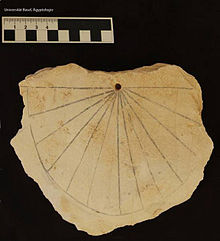日晷的历史

日晷是一种通过使用太阳位置在参考尺规上投射的光点或阴影来指示时间的装置[4]。当地球绕其极轴旋转时,太阳似乎从东向西穿过天空,在太阳升起时从东方地平线下升起,在中午过中天,在日落时再次落在西方地平线下。方位角(方向)和高度角(高度)都可以用来创建时间量测设备。日晷在每个主要文化中都是独立发明的,随着文化的发展,日晷变得更加精确和复杂[5]。
介绍
[编辑]日晷使用当地时间。在19世纪40年代铁路出现之前,当地时间显示在日晷上,供政府和商业使用。在钟表发明之前,日晷是量测时间的唯一方法。时钟发明后,因为早期时钟的精度很差,需要定期从日晷上重置时钟,日晷仍保持了其重要性。时钟和日晷一起用来量测经度。刻度盘是用直尺和圆规摆放的。十九世纪末,日晷成为学术界关注的对象。对数的使用允许采用和研究代数方法来布置刻度盘。日晷不再具有实用性,但仍然是流行的装饰品,几本流行的书促进了这种兴趣,并给出了构造细节。经济实惠的科学计算机使代数方法与几何构造一样易于使用,电脑的使用使表盘设计变得微不足道。日晷的遗产得到了认可,世界各地都建立了日晷协会,某些立法将研究日晷作为其国家课程的一部分[5] 。
历史
[编辑]古代的日晷
[编辑]


根据考古发现,已知最早的家用时钟是古埃及天文学和古巴比伦天文学中的日晷(公元前1500年)。在现代俄罗斯领土上发现了同一时代(约公元前1500年)的古代正投影日晷及其原型[6][7][8][9]。更早的方尖碑,曾经被认为也被用作日晷,放置在为纪念法老而建造的寺庙里,现在认为只是作为纪念[10]。据推测,人类在更早的时候就通过阴影长度来判断时间,但这很难验证。大约在公元前700年,旧约描述了一个日晷:《以赛亚书 38:8》和《列王记》2 Kings 20:9中提到的“亚哈斯的表盘”(可能是历史上最早的日晷),这可能是埃及或巴比伦的设计。日晷也在库施开发[11][12]。日晷自古以来就存在于中国,但人们对其历史知之甚少。众所周知,中国古代在公元前800年左右发明了一种日晷,到公元1000年,日晷最终演变成非常复杂的水钟,在宋朝(公元1000-1400年)的某个时候,日晷上有时也会建造一个指南针[13]。
公元前104年的日晷在行事历专家的集会上被提及。公元前 104 年,在历法专家的集会中就曾提及日晷的应用[14]。
古希腊人发展了许多日晷的原理和形式。据信日晷是由米利都的阿那克西曼德 约560 BCE引入希腊的。根据希罗多德的说法,希腊日晷最初是源自巴比伦的日晷。希腊人在发展日晷科学方面处于有利地位,他们发展了几何学,特别是发现了日晷结点所描绘的圆锥截面。据说数学家和天文学家比提尼亚的狄奥多西(大约公元前160年至大约公元前100年)发明了一种可以在地球上任何地方使用的通用日晷[15]。
相关条目
[编辑]- 傅科摆
- Francesco Bianchini
- Horology
- 苏格兰日晷:古代文艺复兴时期设置在苏格兰的日晷
- Tide (time):早期日晷上对日子的划分
- Wilanów Palace Sundial:约翰·赫维留在1684年建立的日晷。
参考资料
[编辑]- Notes
- ^ Preliminary Report on the Work carried out during the season 2013. [2016-12-28]. (原始内容存档于2016-12-28).
- ^ Bickel, S.; Gautschy, R. Eine ramessidische Sonnenuhr im Tal der Könige. Zeitschrift für Ägyptische Sprache und Altertumskunde 2014, Volume 96, Issue 1, pp. 3-14.
- ^ Vodolazhskaya, L.N. Reconstruction of ancient Egyptian sundials. Archaeoastronomy and Ancient Technologies 2014, 2(2), 1-18.
- ^ Jones 2005,第1页.
- ^ 5.0 5.1 Jones 2005.
- ^ Vodolazhskaya, L.N.; Larenok, P.A.; Nevsky, M.Yu.The ancient astronomical instrument from Srubna burial of kurgan field Tavriya-1 (Northern Black Sea Coast). Archaeologist and Ancient Technologies 2014, 2(2), 31-53. (PDF). [2024-08-07]. (原始内容存档 (PDF)于2023-09-15).
- ^ Vodolazhskaya, L.N. Analemmatic and horizontal sundials of the Bronze Age (Northern Black Sea Coast). Archaeoastronomy and Ancient Technologies 2013, 1(1), 68-88. (PDF). [2024-08-07]. (原始内容存档 (PDF)于2013-10-21).
- ^ Vodolazhskaya L.N., Larenok P.A., Nevsky M.Yu. The prototype of ancient analemmatic sundials (Rostov Oblast, Russia). Archaeoastronomy and Ancient Technologies 2016, 4(1), 96-116. (PDF). [2024-08-07]. (原始内容存档 (PDF)于2023-09-15).
- ^ Vodolazhskaya, L.N.; Larenok, P.A.; Nevsky, M.Yu. Solnechnye chasy epokhi bronzy is srubnogo pogrebeniya mogil'nika Tavriya-1. [Sundial of Bronze Age from the Srubna burial of kurgan field Tavriya-1]. Istoriko-arkheologicheskiy al'manakh. [Historical-Archaeological Almanac]. Vol. 13, Armavir, Krasnodar, Moscow, 2015, p. 4-14.
- ^ The oldest surviving sundial. [2014-12-06]. (原始内容存档于2021-04-11).
- ^ Depuydt, Leo. Gnomons at Meroë and Early Trigonometry. The Journal of Egyptian Archaeology. 1 January 1998, 84: 171–180. JSTOR 3822211. doi:10.2307/3822211.
- ^ Slayman, Andrew. Neolithic Skywatchers. Archaeology Magazine Archive. 27 May 1998 [17 April 2011]. (原始内容存档于5 June 2011).
- ^ Sundials in China - A brief note. The University of Hong Kong. 1997-07-01 [2010-01-20]. (原始内容存档于2010-03-14).
- ^ Joseph Needham. Science and Civilisation in China 3. C.U.P. 1959: 302.
- ^ Heath 1911,第771页.
- Bibliography
- Earle AM. Sundials and Roses of Yesterday. Rutland, VT: Charles E. Tuttle. 1971. ISBN 0-8048-0968-2. LCCN 74142763. Reprint of the 1902 book published by Macmillan (New York).
- A.P.Herbert, Sundials Old and New,Methuen & Co. Ltd, 1967.
- Mayall RN, Mayall MW. Sundials: Their Construction and Use 3rd. Cambridge, MA: Sky Publishing. 1994. ISBN 0-933346-71-9.
- Hugo Michnik, Theorie einer Bifilar-Sonnenuhr, Astronomishe Nachrichten, 217(5190), p. 81-90, 1923
- Rohr RRJ. Sundials: History, Theory, and Practice translated by G. Godin. New York: Dover. 1996. ISBN 0-486-29139-1. Slightly amended reprint of the 1970 translation published by University of Toronto Press (Toronto). The original was published in 1965 under the title Les Cadrans solaires by Gauthier-Villars (Montrouge, France).
- Frederick W. Sawyer, Bifilar gnomonics, JBAA (Journal of the British Astronomical association), 88(4):334–351, 1978
- Gerard L'E. Turner, Antique Scientific Instruments, Blandford Press Ltd. 1980 ISBN 0-7137-1068-3
- J.L. Heilbron, The sun in the church: cathedrals as solar observatories, Harvard University Press, 2001 ISBN 978-0-674-00536-5.
- Make A Sundial, (The Education Group British Sundial Society) Editors Jane Walker and David Brown, British Sundial Society 1991 ISBN 0-9518404-0
- Waugh AE. Sundials: Their Theory and Construction. New York: Dover Publications. 1973. ISBN 0-486-22947-5.
- "Illustrating Shadows", Simon Wheaton-Smith, ISBN 0-9765286-8-1, LCN: 2005900674
- "Illustrating More Shadows", Simon Wheaton-Smith, both books are over 300 pages long.
外部链接
[编辑]- British Sundial Society (页面存档备份,存于互联网档案馆)- Time line and register
- The Ancient Vedic Sun Dial (页面存档备份,存于互联网档案馆)
